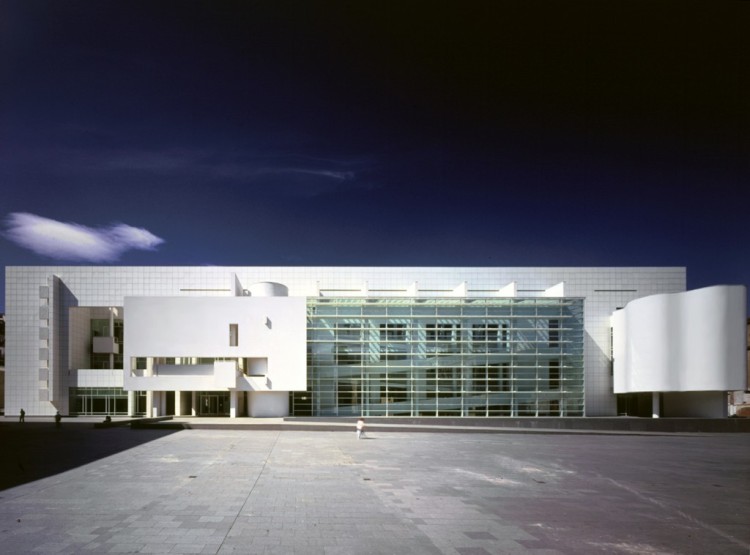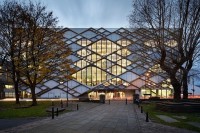
Building Study – Bibliotheca Alexandrina
Eleven story partially submerged library that also contains cultural and educational functions such as planetarium, several museums, a school for social science and conservation facilities. The circular tilting form spans 160 metres in diameter, reaches 32 metres in height and 12 meres into the ground. Its vast circular form recalls the cyclical nature of knowledge, fluid throughout time.


Automated Storage & Retrieval System
Glucksman Library
Macquarie Library
Jerry Falwell Library ASRS
Architectural Review – Typology: Library
The article by Oriel Prizeman explains that the history of the public library is relatively short – approximately 160 years – and is said to be closely related to progressing the right of people to determine their own affairs. ‘While all buildings designed to contain books are potentially engaging, it is those which negotiate the direct interface between a body of knowledge and an open public realm that face the most complex challenges’. Prizeman identifies two key pragmatic aspects that dominated the theory of library design before the period of technological advancement that began in the 1980’s. These are the physical space for containment and the ability to maintain environmental control.
Early radial plans emerged by placing surveillance in the centre of the building to enable librarians to monitor readers with optimum efficiency.
British Museum Reading Room, Robert Smirke, 1857

Seinajoki Library, Alvar Aalto, 1965

Prizeman reviews current library examples to identify enduring themes.
Library of Birmingham, Mecanoo, 2013

The building is described as being clearly conceived in navigational terms, on entering the visitors have direct views in all directions giving clear lines of sight. ‘The core of the building is excavated by a spiraling series of offset cylindrical courts providing natural ventilation. In the middle of the building, the rotund is surrounded by browsable books with reading rooms located at the periphery, close to the light.’
King Abdulaziz Center for World Culture, Snohetta, 2012

The building is described as using separate elements to represent links between past, present and future. A cluster of organic forms house diverse cultural facilities, including an auditorium, cinema, museum, children zone, multi function hall, library and learning spaces. Prizeman explains that the combination of programmes is not new but placing these uses in this social and environmental context is a innovative approach.
Rolex Learning Center, SANNA, 2010

The building is described by its architect as an ‘intimate public space’, the undulating floor and ceiling planes are punctuated by holes that admit light from above and the gardens from below. According to Prizeman the continuous open space seeks to respond to a global trend in academia to encourage cross-fertilisation of ideas and interdisciplinary research. The scheme emphasises both the new and established values of is programme.
Bibliotheque Multimeia a Vocation Regionale, OMA, 2015

The building is formed by two intersecting blocks arranged to create an irregular cross, the points of the cross face historical city landmarks in each direction. Each of the four planes house a pedagogic discipline – human sciences, science & technology, literature and the arts. At the intersection point a large reading room encourages maximum flow between departments.
Biblioteca Espana, Mazzanti & Arquitectos, 2008

The building is described as follows: ‘Poised like giant bounlders above the basin of Medellin, the library has the iconic presence of a religious statue, giving visual order over a jumbled townscape beneath it.
The themes
- Place making expressive architectural forms,
- Open-plan to encourage interaction and views,
- Public space is central to each design, a civic centre where people meet and share,
- Diverse cultural facilities rather than simple functional space,
- Libraries are being framed as an symbol of cultural establishment,
- Accidental encounter and social interaction is the promise of the new library,
- Buildings with moral status should deliver enviable environment innovation,
‘Since the infinite space of the internet may be accessed from the private realm of the home computer, the library provides containment, and the characterisation of its identity through scale and form has become critical’
Architectural Review, Typology: Libraries Oriel Prizeman 02/11/11
Alternative Sites – Northern Quarter

Piccadilly Basin
Building Visit – The Hub, Coventry University
Building Visit – Diamond Building, Sheffield
Competition Site – Future Library
Competition Brief – Future Library




































